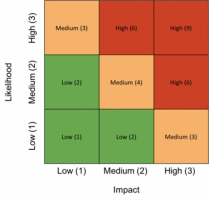10 Key Principles of Effective Project Risk Management
- 2024-02-23 11:30:00
- Natasha Thakkar
- Original 788
Risk is an inherent part of our lives—it’s present in almost every decision we make. Whether that’s crossing the road, buying a house, or choosing our words when meeting the in-laws!
When it comes to project risk management, the stakes are so much higher than you’re used to. Not only must you manage yourself and your team, but you must also consider external risks. This can include market conditions, competitors, stakeholders, and industry regulations.
And even then, when you think that everything is under control, a brand-new problem pops up This concept was famously expressed by Donald Rumsfeld, the former US Secretary of Defence:
“There are known knowns. These are things we know that we know. There are known unknowns. That is to say, there are things that we know we don’t know. But there are also unknown unknowns. There are things we don’t know we don’t know.”
Every project has its vulnerabilities, the problem is identifying the ones that matter. When there’s such a wide scope for error, managers must:
- Have a method for proactively addressing uncertainties.
- Have a damage control plan for when things inevitably go wrong.
In need of a project management refresher? This page explores 10 key principles of risk management that you should know about.
10 Key Principles of Effective Project Risk Management
1. Understand the Project’s Scope
The first step with project management is to define what your objectives are—after all, this is what gives direction to your actions. Outline what the key deliverables are and who’s responsible for each aspect of your project. This creates accountability but also defines boundaries, which is essential for avoiding scope creep.
2. Rank Risks by Threat Level
Not all risk factors are created equal. It’s important that you scale your risk management to each. Once you’ve identified the key risks that could affect your project, evaluate the likelihood and impact of each factor. Use the Boston Square matrix to quantify the approach that you should take. Consider the time, cost, and resources needed to deal with each risk factor.
Image Source: andrewsheves.com
3. Emphasize Open Communication
Communication is what keeps teams ticking. It’s important to promote honesty and openness in sharing project-related information. Team leaders should try to foster a shared mindset where everyone feels free to voice their concerns.
When recruiting employees, use your ATS solution to measure and track their communication skills. Being qualified for the role doesn’t mean that someone is the best fit for your company.
Fostering open communication can also be applied to your relationship with your customers by gathering feedback. Understanding your project's health can be enhanced by assessing your Net Promoter Score (NPS). Learning how to calculate NPS is a valuable method for gathering feedback from stakeholders and clients to uncover additional insights into potential risks.
4. Engage with Your Stakeholders
Stakeholders are integral to any project’s success. They provide the financial backing for your business’s operations and employees’ wages.
You should inform stakeholders of all risk-related activities and, even better, involve them in the decision-making process. They are likely to be subject matter experts whose insights can help uncover risks that might be overlooked otherwise.
5. Keep Evidence of Everything
Make sure to document all identified risks, their potential impacts, and proposed mitigation strategies. Not only will this serve as a reference point for anyone working on the project, but it also provides evidence to stakeholders that risk management principles are being followed.
Software applications can alleviate much of the manual workload here. For example, using programs to automatically transcribe meeting notes or to track a call.
6. Maintain a Risk Log
Your risk log is the central database for recording and managing project risks. It’s where anyone can report concerns, which are then assessed and prioritized by project managers. Ideally, your risk log should attach responsibilities to team members (i.e. the ‘risk owners’). It should also provide status updates as risks are dealt with or grow worse.
7. Prepare Contingency Plans
Your contingency plans, then, are the proactive strategies you develop to address specific risks identified in the risk log. It further defines what the risk is, what measures must be taken if the risk materializes, and what should ‘trigger’ that set of actions.
You should also make sure a communication plan is integrated into this—with clear escalation procedures and points of contact.
8. Use Reliable, Feature-Rich Software
Your project is only as resilient as the software you use.
For example, if you rely on just one application to communicate with one another, and it suddenly goes offline, that represents a huge pitfall for your business. Even with contingency plans in place, your best bet is to invest in software that you know will stay functional when you need it the most.
ZenTao offers both self-hosted and cloud project management software with all the integrations and reporting tools that you’ll need to stay on top of emerging risks.
9. Host Regular Risk Reviews
A key part of risk management is to constantly scan the horizon for emerging threats. Schedule time to review your risk logs and identify any problems that seem to be getting worse without explanation. Assign responsibilities to team members so everyone knows what their role is.
In the era of hybrid working, it can be harder to get your team involved in this process. Try to make the most of collaborative software like online workflow systems, real-time document editing apps, and screen sharing software. The more connected your team are, the faster you can deal with problems as they arise.
10. Make Sure Your Team is On Board
In short, risk management is easier when your team is close-knit and loyal.
Holding onto your top talent doesn’t just save you money on the endless recruitment cycle, but it also contributes to a positive company culture. When employees feel empowered in their roles, they’re far more likely to speak up when something doesn’t seem right.
Achieving this requires action at the very beginning of the employee journey. Nurture relationships with applicants through your recruiter CRM, and make risk management a key part of your onboarding program. Provide employees with the support they need to identify and freely report issues.
Conclusion
Effective project risk management is all about adopting a proactive mindset. Constantly chasing problems is an unhealthy position for a business to be in. Your supervisors and employees will suffer from burnout. And above all, it sends the worst possible message to clients, partners, and stakeholders.
To get started, be sure to adopt productivity-enhancing software. This will help you to maintain the necessary documentation and keep your team connected. A collaborative culture is the best way to stay on top of the risk factors that affect your company.
Products
- ZDOO
- ZDOO Cloud
Support
- Book a Demo
- Tech Forum
- GitHub
- SourceForge
About Us
- Company
- Privacy Policy
- Term of Use
- Blogs
- Partners
Contact Us
- Leave a Message
- Email Us: support@zentaoalm.com








